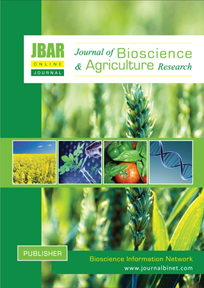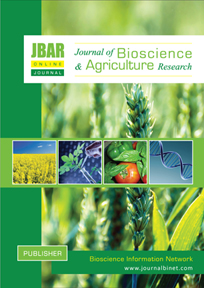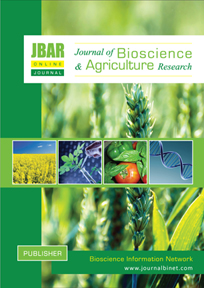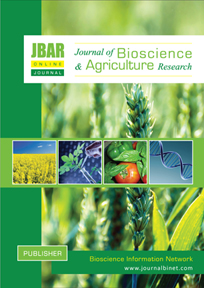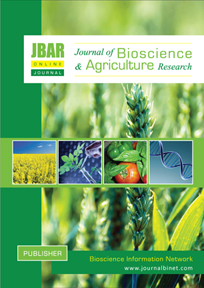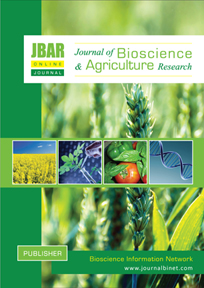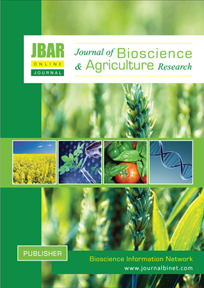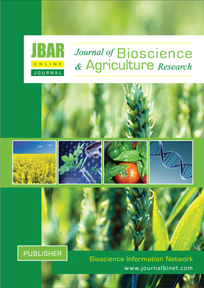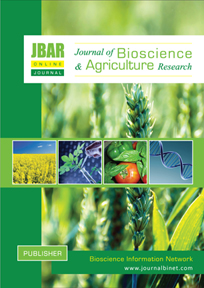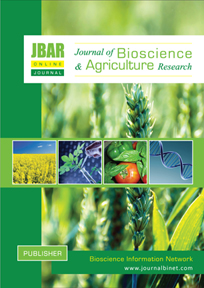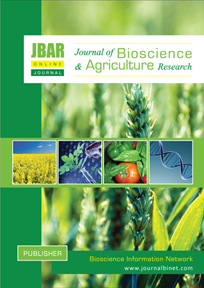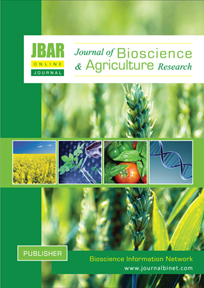Journal of Bioscience and Agriculture Research
Volume 12 - Issue 01 | Year of Publication: 2017
Article Type: Research Article | No. 119, 2017 | Country: Bangladesh | pp. 968-975 | Open Access
Title: Density based sustainable fingerling production techniques of indigenous major carp, Labeo rohita (Hamilton, 1822) in ponds of Bangladesh
Authors: Samad, M. A., Arafat, M. Y., Ferdaushy, H., Chatterjee, S. K., Paul, A. K. & Rahman, M. M.
DOI: http://dx.doi.org/10.18801/jbar.120117.119
Title: Density based sustainable fingerling production techniques of indigenous major carp, Labeo rohita (Hamilton, 1822) in ponds of Bangladesh
Authors: Samad, M. A., Arafat, M. Y., Ferdaushy, H., Chatterjee, S. K., Paul, A. K. & Rahman, M. M.
DOI: http://dx.doi.org/10.18801/jbar.120117.119
Title: Density based sustainable fingerling production techniques of indigenous major carp, Labeo rohita (Hamilton, 1822) in ponds of Bangladesh
Abstract: Density based fingerling production technique of indigenous major carp (Labeo rohita) was conducted in ponds from 14th August to 14th October, 2013. Experiment was carried out under rearing pond with three treatments group each having three replicates. Size of the stocked fries was 1.5±0.12 cm length and 0.43±0.13 g weight. Stocked fries (Labeo rohita) were collected from Rajshahi City Hatchery, Rajshahi. Stocking density was maintained at 400000/ha (T1), 500000/ha (T2), 600000/ha (T3) respectively. Fishes were fed same diet in three different treatments consisting of 25.5% protein at the rate of 8- 10% of body weight. Also same type of fertilizers was used in three different treatments consisting of Cowdung, Urea, and T.S.P. Physico-chemical characteristics of pond water were measured fortnightly. Mean values of some water quality parameters such as temperature (°C) were 31.18±1.33 (T1), 31.21±1.37 (T2), 31.12±1.25 (T3); dissolved oxygen (mg/l) 6.65±0.54 (T1), 6.61±0.48 (T2), 7.05±0.28 (T3); carbon dioxide (mg/l) 6.75±0.53 (T1), 6.49±0.56 (T2), 6.70±0.50 (T3) and pH 6.08±0.21 (T1), 7.04±0.22 (T2), 7.18±0.17 (T3); transparency (cm) 39.92±0.60 (T1), 39.91±0.58 (T2), 89.87±0.74 (T3) respectively. Sampling was also done fortnightly. Mean value of final length (cm) 7.76±0.12 (T1) 7.74±0.12 (T2) 7.70±0.14 (T3) and the mean value of final weight (g) was 4.98±0.25 (T1), 4.61±0.32 (T2), 4.37±0.32 (T3). Survival rate of Labeo rohita was 74.96% (T1), 66.50% (T2), and 62.50% (T3) respectively. Highest survivability was found in T1. The production (kg/ha) of Labeo rohita fry was 1392.02±64.83 (T1), 1419.77±96.26 (T2), 1511.05±96.70 (T3) respectively. The highest production was found in T3. Higher CBR was found from treatment T1 (1:2.71) than from treatment T2 (1:2.40) and T3 (1:2.47). From the study it is evident that lower stocking density effective for optimum result in the growth of Labeo rohita fry.
Key Words: Fingerling, Indigenous, Labeo rohita, Major carp and Stocking density
Abstract: Density based fingerling production technique of indigenous major carp (Labeo rohita) was conducted in ponds from 14th August to 14th October, 2013. Experiment was carried out under rearing pond with three treatments group each having three replicates. Size of the stocked fries was 1.5±0.12 cm length and 0.43±0.13 g weight. Stocked fries (Labeo rohita) were collected from Rajshahi City Hatchery, Rajshahi. Stocking density was maintained at 400000/ha (T1), 500000/ha (T2), 600000/ha (T3) respectively. Fishes were fed same diet in three different treatments consisting of 25.5% protein at the rate of 8- 10% of body weight. Also same type of fertilizers was used in three different treatments consisting of Cowdung, Urea, and T.S.P. Physico-chemical characteristics of pond water were measured fortnightly. Mean values of some water quality parameters such as temperature (°C) were 31.18±1.33 (T1), 31.21±1.37 (T2), 31.12±1.25 (T3); dissolved oxygen (mg/l) 6.65±0.54 (T1), 6.61±0.48 (T2), 7.05±0.28 (T3); carbon dioxide (mg/l) 6.75±0.53 (T1), 6.49±0.56 (T2), 6.70±0.50 (T3) and pH 6.08±0.21 (T1), 7.04±0.22 (T2), 7.18±0.17 (T3); transparency (cm) 39.92±0.60 (T1), 39.91±0.58 (T2), 89.87±0.74 (T3) respectively. Sampling was also done fortnightly. Mean value of final length (cm) 7.76±0.12 (T1) 7.74±0.12 (T2) 7.70±0.14 (T3) and the mean value of final weight (g) was 4.98±0.25 (T1), 4.61±0.32 (T2), 4.37±0.32 (T3). Survival rate of Labeo rohita was 74.96% (T1), 66.50% (T2), and 62.50% (T3) respectively. Highest survivability was found in T1. The production (kg/ha) of Labeo rohita fry was 1392.02±64.83 (T1), 1419.77±96.26 (T2), 1511.05±96.70 (T3) respectively. The highest production was found in T3. Higher CBR was found from treatment T1 (1:2.71) than from treatment T2 (1:2.40) and T3 (1:2.47). From the study it is evident that lower stocking density effective for optimum result in the growth of Labeo rohita fry.
Key Words: Fingerling, Indigenous, Labeo rohita, Major carp and Stocking density
HOW TO CITE THIS ARTICLE?
APA (American Psychological Association)
Samad, M. A., Arafat, M. Y., Ferdaushy, H., Chatterjee, S. K., Paul, A. K. & Rahman, M. M. (2017). Density based sustainable fingerling production techniques of indigenous major carp, Labeo rohita (Hamilton, 1822) in ponds of Bangladesh. Journal of Bioscience and Agriculture Research, 12(01), 968-975.
MLA (Modern Language Association)
Samad, M. A., Arafat, M. Y., Ferdaushy, H., Chatterjee, S. K., Paul, A. K. & Rahman, M. M. “Density based sustainable fingerling production techniques of indigenous major carp, Labeo rohita (Hamilton, 1822) in ponds of Bangladesh”. Journal of Bioscience and Agriculture Research, 12.01(2017): 968-975.
Chicago and or Turabian
Samad, M. A., Arafat, M. Y., Ferdaushy, H., Chatterjee, S. K., Paul, A. K. & Rahman, M. M. “Density based sustainable fingerling production techniques of indigenous major carp, Labeo rohita (Hamilton, 1822) in ponds of Bangladesh”. Journal of Bioscience and Agriculture Research, 12 no.01(2017): 968-975.
APA (American Psychological Association)
Samad, M. A., Arafat, M. Y., Ferdaushy, H., Chatterjee, S. K., Paul, A. K. & Rahman, M. M. (2017). Density based sustainable fingerling production techniques of indigenous major carp, Labeo rohita (Hamilton, 1822) in ponds of Bangladesh. Journal of Bioscience and Agriculture Research, 12(01), 968-975.
MLA (Modern Language Association)
Samad, M. A., Arafat, M. Y., Ferdaushy, H., Chatterjee, S. K., Paul, A. K. & Rahman, M. M. “Density based sustainable fingerling production techniques of indigenous major carp, Labeo rohita (Hamilton, 1822) in ponds of Bangladesh”. Journal of Bioscience and Agriculture Research, 12.01(2017): 968-975.
Chicago and or Turabian
Samad, M. A., Arafat, M. Y., Ferdaushy, H., Chatterjee, S. K., Paul, A. K. & Rahman, M. M. “Density based sustainable fingerling production techniques of indigenous major carp, Labeo rohita (Hamilton, 1822) in ponds of Bangladesh”. Journal of Bioscience and Agriculture Research, 12 no.01(2017): 968-975.
Article Type: Research Article | No. 120, 2017 | Country: Bangladesh | pp. 976-985 | Open Access
Title: Biochemical investigation and seedling mortality rate of some selected boro rice cultivars at low temperature stress
Authors: Basunia, S. C., Sarker, B. C., Kayess, M. O., Rahman, M. I., Kajal, M. & Alam, M. R.
DOI: http://dx.doi.org/10.18801/jbar.120117.120
Title: Biochemical investigation and seedling mortality rate of some selected boro rice cultivars at low temperature stress
Authors: Basunia, S. C., Sarker, B. C., Kayess, M. O., Rahman, M. I., Kajal, M. & Alam, M. R.
DOI: http://dx.doi.org/10.18801/jbar.120117.120
Title: Biochemical investigation and seedling mortality rate of some selected boro rice cultivars at low temperature stress
Abstract: A field study was conducted for biochemical investigation and seedling mortality rate determination of some selected Boro rice seedlings during the period of December, 2014 to January, 2015. Experiment time was characterized by prevailing low environmental temperature of below 15oC. Eight rice cultivars (V1: Pariza; V2: BRRI dhan29; V3: Shaita Boro; V4: BRRI dhan 28; V5: Jotapari; V6: BRRI dhan 16; V7: Pashushail; V8: Hybrid SL-8H) of different genetic constituents were evaluated in randomized complete block design with four replications. Two temperature regime was applied for seedling culture. Ambient temperature (T0) for field investigation and 4oC temperature (T1) environment was maintained only for physiological parameters. Changes of leaf Proline content, chlorophyll content (a and b), total carotenoid content and mortality rate were investigated. Result showed that V8 (Hybrid SL-8H) and V2 (BRRI dhan 29) seedling synthesized the maximum leaf Proline at low temperature than other cultivars. Highest amount of chlorophyll-a, was in V8T0 seedlings (10.03 mg g-1), while chlorophyll-b (2.063 mg g-1) and total carotenoid (4.0470 mg g-1) were highest in V3T0. Maximum chlorophyll-a/b ratio (6.729 mg) was recorded in V7T0. Mortality rate was lowest in Hybrid SL-8H. Results of the study revealed that Hybrid SL-8H cultivars howed comparatively better potentiality to survive at low temperature that might be selected for cultivation and popularization in the low temperature region of Bangladesh.
Key Words: Boro rice, Low temperature, Bio chemicals, Mortality and Selection
Abstract: A field study was conducted for biochemical investigation and seedling mortality rate determination of some selected Boro rice seedlings during the period of December, 2014 to January, 2015. Experiment time was characterized by prevailing low environmental temperature of below 15oC. Eight rice cultivars (V1: Pariza; V2: BRRI dhan29; V3: Shaita Boro; V4: BRRI dhan 28; V5: Jotapari; V6: BRRI dhan 16; V7: Pashushail; V8: Hybrid SL-8H) of different genetic constituents were evaluated in randomized complete block design with four replications. Two temperature regime was applied for seedling culture. Ambient temperature (T0) for field investigation and 4oC temperature (T1) environment was maintained only for physiological parameters. Changes of leaf Proline content, chlorophyll content (a and b), total carotenoid content and mortality rate were investigated. Result showed that V8 (Hybrid SL-8H) and V2 (BRRI dhan 29) seedling synthesized the maximum leaf Proline at low temperature than other cultivars. Highest amount of chlorophyll-a, was in V8T0 seedlings (10.03 mg g-1), while chlorophyll-b (2.063 mg g-1) and total carotenoid (4.0470 mg g-1) were highest in V3T0. Maximum chlorophyll-a/b ratio (6.729 mg) was recorded in V7T0. Mortality rate was lowest in Hybrid SL-8H. Results of the study revealed that Hybrid SL-8H cultivars howed comparatively better potentiality to survive at low temperature that might be selected for cultivation and popularization in the low temperature region of Bangladesh.
Key Words: Boro rice, Low temperature, Bio chemicals, Mortality and Selection
HOW TO CITE THIS ARTICLE?
APA (American Psychological Association)
Basunia, S. C., Sarker, B. C., Kayess, M. O., Rahman, M. I., Kajal, M. & Alam, M. R. (2017). Biochemical investigation and seedling mortality rate determination of some selected boro rice cultivarss at low temperature stress. Journal of Bioscience and Agriculture Research, 12(01), 976-985.
MLA (Modern Language Association)
Basunia, S. C., Sarker, B. C., Kayess, M. O., Rahman, M. I., Kajal, M. & Alam, M. R. “Biochemical investigation and seedling mortality rate determination of some selected boro rice cultivarss at low temperature stress”. Journal of Bioscience and Agriculture Research, 12.01(2017):976-985.
Chicago and or Turabian
Basunia, S. C., Sarker, B. C., Kayess, M. O., Rahman, M. I., Kajal, M. & Alam, M. R. “Biochemical investigation and seedling mortality rate determination of some selected boro rice cultivarss at low temperature stress”. Journal of Bioscience and Agriculture Research, 12 no.01(2017): 976-985.
APA (American Psychological Association)
Basunia, S. C., Sarker, B. C., Kayess, M. O., Rahman, M. I., Kajal, M. & Alam, M. R. (2017). Biochemical investigation and seedling mortality rate determination of some selected boro rice cultivarss at low temperature stress. Journal of Bioscience and Agriculture Research, 12(01), 976-985.
MLA (Modern Language Association)
Basunia, S. C., Sarker, B. C., Kayess, M. O., Rahman, M. I., Kajal, M. & Alam, M. R. “Biochemical investigation and seedling mortality rate determination of some selected boro rice cultivarss at low temperature stress”. Journal of Bioscience and Agriculture Research, 12.01(2017):976-985.
Chicago and or Turabian
Basunia, S. C., Sarker, B. C., Kayess, M. O., Rahman, M. I., Kajal, M. & Alam, M. R. “Biochemical investigation and seedling mortality rate determination of some selected boro rice cultivarss at low temperature stress”. Journal of Bioscience and Agriculture Research, 12 no.01(2017): 976-985.
Article Type: Research Article | No. 121, 2017 | Country: Bangladesh | pp. 996-1002 | Open Access
Title: Socio-economic impact and profitability of liming by dolochun on vegetable production in acidic soil of Sreepur, Gazipur
Authors: Hasan, M. M., Pramanik, S., Haq, M. E. & Tareq, M. Z.
DOI: http://dx.doi.org/10.18801/jbar.120117.121
Title: Socio-economic impact and profitability of liming by dolochun on vegetable production in acidic soil of Sreepur, Gazipur
Authors: Hasan, M. M., Pramanik, S., Haq, M. E. & Tareq, M. Z.
DOI: http://dx.doi.org/10.18801/jbar.120117.121
Title: Socio-economic impact and profitability of liming by dolochun on vegetable production in acidic soil of Sreepur, Gazipur
Abstract: Impact of dolochun in terms of changes in yield and profitability of selected vegetables were studied. Sreepur upazila of Gazipur district was the location of this study. Sixty respondents were selected as the sample of the study by using proportionate random sampling technique. Data were collected with the help of an interview schedule. Statistical measures such as mean, number, percentage, standard deviation and t-test were administered to express result. Production of bitter gourd, snake gourd, red amaranth and ladies finger increased significantly and return found from the yield of those selected vegetables also increase significantly after adoption of dolochun technology. The benefit cost ratio (BCR) of selected vegetables such as bitter gourd, snake gourd, red amaranth and ladies finger was found 2.50, 2.41, 2.24 & 2.39 after application of dolochun before that it was 2.12, 2.09, 1.98 & 2.14 respectively. The study reflects that dolochun application can improve the yield efficiency and will help to increase profitability of the farmers.
Key Words: Vegetable, Soil acidity, Dolochun, Yield and Profitabiliy
Abstract: Impact of dolochun in terms of changes in yield and profitability of selected vegetables were studied. Sreepur upazila of Gazipur district was the location of this study. Sixty respondents were selected as the sample of the study by using proportionate random sampling technique. Data were collected with the help of an interview schedule. Statistical measures such as mean, number, percentage, standard deviation and t-test were administered to express result. Production of bitter gourd, snake gourd, red amaranth and ladies finger increased significantly and return found from the yield of those selected vegetables also increase significantly after adoption of dolochun technology. The benefit cost ratio (BCR) of selected vegetables such as bitter gourd, snake gourd, red amaranth and ladies finger was found 2.50, 2.41, 2.24 & 2.39 after application of dolochun before that it was 2.12, 2.09, 1.98 & 2.14 respectively. The study reflects that dolochun application can improve the yield efficiency and will help to increase profitability of the farmers.
Key Words: Vegetable, Soil acidity, Dolochun, Yield and Profitabiliy
HOW TO CITE THIS ARTICLE?
APA (American Psychological Association)
Hasan, M. M., Pramanik, S., Haq, M. E. & Tareq, M. Z. (2017). Socio-economic impact and profitability of liming by dolochun on vegetable production in acidic soil of Sreepur, Gazipur. Journal of Bioscience and Agriculture Research, 12(01), 996-1002.
MLA (Modern Language Association)
Hasan, M. M., Pramanik, S., Haq, M. E. & Tareq, M. Z. “Socio-economic impact and profitability of liming by dolochun on vegetable production in acidic soil of Sreepur, Gazipur”. Journal of Bioscience and Agriculture Research, 12.01(2017), 996-1002.
Chicago/Turabian
Hasan, M. M., Pramanik, S., Haq, M. E. & Tareq, M. Z. “Socio-economic impact and profitability of liming by dolochun on vegetable production in acidic soil of Sreepur, Gazipur”. Journal of Bioscience and Agriculture Research, 12. no. 01(2017), 996-1002.
APA (American Psychological Association)
Hasan, M. M., Pramanik, S., Haq, M. E. & Tareq, M. Z. (2017). Socio-economic impact and profitability of liming by dolochun on vegetable production in acidic soil of Sreepur, Gazipur. Journal of Bioscience and Agriculture Research, 12(01), 996-1002.
MLA (Modern Language Association)
Hasan, M. M., Pramanik, S., Haq, M. E. & Tareq, M. Z. “Socio-economic impact and profitability of liming by dolochun on vegetable production in acidic soil of Sreepur, Gazipur”. Journal of Bioscience and Agriculture Research, 12.01(2017), 996-1002.
Chicago/Turabian
Hasan, M. M., Pramanik, S., Haq, M. E. & Tareq, M. Z. “Socio-economic impact and profitability of liming by dolochun on vegetable production in acidic soil of Sreepur, Gazipur”. Journal of Bioscience and Agriculture Research, 12. no. 01(2017), 996-1002.
Article Type: Research Article | No. 122, 2017 | Country: Ethiopia | pp. 1003-1015 | Open Access
Title: Yield and leaf nutrient concentrations of common bean genotypes as influenced by aluminium toxicity under acidic soils
Authors: Legesse, H., Dechassa, N., Gebeyehu, S., Bultosa,G.& Mekbib,F.
DOI: http://dx.doi.org/10.18801/jbar.120117.122
Title: Yield and leaf nutrient concentrations of common bean genotypes as influenced by aluminium toxicity under acidic soils
Authors: Legesse, H., Dechassa, N., Gebeyehu, S., Bultosa,G.& Mekbib,F.
DOI: http://dx.doi.org/10.18801/jbar.120117.122
Title: Yield and leaf nutrient concentrations of common bean genotypes as influenced by aluminium toxicity under acidic soils
Abstract: The study was carried out to assess the effect of different concentrations of exchangeable aluminum on yield and nutrient concentrations in the leaf tissues of two common bean genotypes grown in pots on limed and unlimed acidic soils. Factorial combinations of five aluminum rates and two common bean genotypes were laid out in a completely randomized design with three replications. Yield and leaf nutrient concentrations were markedly affected by aluminium application and the magnitude of this effect depended on the genotype, on the levels of aluminium applied, and liming regimes. On average, the genotypes suffered 10.8% (new BILFA 58) and 24.5% (Roba 1) reductions in grain yield when grown on unlimed soil than limed soil. Lime application increased nutrient content of the leaf (28.5% P, 36.9% Ca, 4.91% K and 14.7% N) and reduced aluminium (56.4%) concentrations in the leaf tissue compared to limed soil. It is concluded that applying aluminum significantly decreased yield and nutrient uptake of both genotypes under both liming regimes.
Key Words: Aluminium toxicity, Genotypes, Grain yield, Lime and Nutrient concentrations
Abstract: The study was carried out to assess the effect of different concentrations of exchangeable aluminum on yield and nutrient concentrations in the leaf tissues of two common bean genotypes grown in pots on limed and unlimed acidic soils. Factorial combinations of five aluminum rates and two common bean genotypes were laid out in a completely randomized design with three replications. Yield and leaf nutrient concentrations were markedly affected by aluminium application and the magnitude of this effect depended on the genotype, on the levels of aluminium applied, and liming regimes. On average, the genotypes suffered 10.8% (new BILFA 58) and 24.5% (Roba 1) reductions in grain yield when grown on unlimed soil than limed soil. Lime application increased nutrient content of the leaf (28.5% P, 36.9% Ca, 4.91% K and 14.7% N) and reduced aluminium (56.4%) concentrations in the leaf tissue compared to limed soil. It is concluded that applying aluminum significantly decreased yield and nutrient uptake of both genotypes under both liming regimes.
Key Words: Aluminium toxicity, Genotypes, Grain yield, Lime and Nutrient concentrations
HOW TO CITE THIS ARTICLE?
APA (American Psychological Association)
Legesse, H., Dechassa, N., Gebeyehu, S., Bultosa,G.& Mekbib,F. (2017). Yield and leaf nutrient concentrations of common bean genotypes as influenced by aluminium toxicity under acidic soils. Journal of Bioscience and Agriculture Research,12(01), 1003-1015.
MLA (Modern Language Association)
Legesse, H., Dechassa, N., Gebeyehu, S., Bultosa,G.& Mekbib,F. “Yield and leaf nutrient concentrations of common bean genotypes as influenced by aluminium toxicity under acidic soils”. Journal of Bioscience and Agriculture Research, 12.01(2017), 1003-1015.
Chicago/Turabian
Legesse, H., Dechassa, N., Gebeyehu, S., Bultosa,G.& Mekbib,F. “Yield and leaf nutrient concentrations of common bean genotypes as influenced by aluminium toxicity under acidic soils”. Journal of Bioscience and Agriculture Research, 12. no. 01(2017), 1003-1015.
APA (American Psychological Association)
Legesse, H., Dechassa, N., Gebeyehu, S., Bultosa,G.& Mekbib,F. (2017). Yield and leaf nutrient concentrations of common bean genotypes as influenced by aluminium toxicity under acidic soils. Journal of Bioscience and Agriculture Research,12(01), 1003-1015.
MLA (Modern Language Association)
Legesse, H., Dechassa, N., Gebeyehu, S., Bultosa,G.& Mekbib,F. “Yield and leaf nutrient concentrations of common bean genotypes as influenced by aluminium toxicity under acidic soils”. Journal of Bioscience and Agriculture Research, 12.01(2017), 1003-1015.
Chicago/Turabian
Legesse, H., Dechassa, N., Gebeyehu, S., Bultosa,G.& Mekbib,F. “Yield and leaf nutrient concentrations of common bean genotypes as influenced by aluminium toxicity under acidic soils”. Journal of Bioscience and Agriculture Research, 12. no. 01(2017), 1003-1015.
Article Type: Research Article | No. 123, 2017 | Country: Bangladesh | pp. 1016-1020 | Open Access
Title: Effect of plant growth regulators on growth and flowering of tuberose (Polianthes tuberosa L.) cv. single
Authors: M. R. Amin, N. Pervin, A. Nusrat, H. Mehraj and A. F. M. Jamal Uddin
DOI: http://dx.doi.org/10.18801/jbar.120117.123
Title: Effect of plant growth regulators on growth and flowering of tuberose (Polianthes tuberosa L.) cv. single
Authors: M. R. Amin, N. Pervin, A. Nusrat, H. Mehraj and A. F. M. Jamal Uddin
DOI: http://dx.doi.org/10.18801/jbar.120117.123
Title: Effect of plant growth regulators on growth and flowering of tuberose (Polianthes tuberosa L.) cv. single
Abstract: A field experiment was conducted to study the effect of plant growth regulators on growth and yield of tuberose (Polianthes tuberosa L.). Treatments of the experiment were as control (No plant growth regulators), NAA 100 ppm, NAA 200 ppm, NAA 300 ppm, NAA 400 ppm, GA3 100 ppm, GA3 200 ppm, GA3 300 ppm, GA3 400 ppm, 4-CPA 100 ppm, 4-CPA 200 ppm, 4-CPA 300 ppm and 4-CPA 400 ppm. Different concentration of growth regulators showed significant variation on most of the parameters. Tallest tuberose plant (68.9 cm), longest length of rachis (21.9 cm), highest number of floret/spike (41.2), highest diameter of spike (1.1 cm), maximum weight of single spike (40.1 g) and highest number of spikes per hectare (3.9 lac) were obtained from GA3 at 300 ppm.
Key Words: Polianthes tuberosa, GA3, NAA and CPA
Abstract: A field experiment was conducted to study the effect of plant growth regulators on growth and yield of tuberose (Polianthes tuberosa L.). Treatments of the experiment were as control (No plant growth regulators), NAA 100 ppm, NAA 200 ppm, NAA 300 ppm, NAA 400 ppm, GA3 100 ppm, GA3 200 ppm, GA3 300 ppm, GA3 400 ppm, 4-CPA 100 ppm, 4-CPA 200 ppm, 4-CPA 300 ppm and 4-CPA 400 ppm. Different concentration of growth regulators showed significant variation on most of the parameters. Tallest tuberose plant (68.9 cm), longest length of rachis (21.9 cm), highest number of floret/spike (41.2), highest diameter of spike (1.1 cm), maximum weight of single spike (40.1 g) and highest number of spikes per hectare (3.9 lac) were obtained from GA3 at 300 ppm.
Key Words: Polianthes tuberosa, GA3, NAA and CPA
HOW TO CITE THIS ARTICLE?
APA (American Psychological Association)
Amin, M.R., Pervin, N., Nusrat, A., Mehraj, H. & Jamal Uddin, A.F.M. (2017). Effect of plant growth regulators on growth and flowering of tuberose (Polianthes tuberosa L.) cv. single. Journal of Bioscience and Agriculture Research, 12(01), 1016-1020.
MLA (Modern Language Association)
Amin, M.R., Pervin, N., Nusrat, A., Mehraj, H. & Jamal Uddin, A.F.M. “Effect of plant growth regulators on growth and flowering of tuberose (Polianthes tuberosa L.) cv. Single”. Journal of Bioscience and Agriculture Research, 12.01(2017), 1016-1020.
Chicago and or Turabian
Amin, M.R., Pervin, N., Nusrat, A., Mehraj, H. & Jamal Uddin, A.F.M. “Effect of plant growth regulators on growth and flowering of tuberose (Polianthes tuberosa L.) cv. Single”. Journal of Bioscience and Agriculture Research, 12. no.01(2017), 1016-1020.
APA (American Psychological Association)
Amin, M.R., Pervin, N., Nusrat, A., Mehraj, H. & Jamal Uddin, A.F.M. (2017). Effect of plant growth regulators on growth and flowering of tuberose (Polianthes tuberosa L.) cv. single. Journal of Bioscience and Agriculture Research, 12(01), 1016-1020.
MLA (Modern Language Association)
Amin, M.R., Pervin, N., Nusrat, A., Mehraj, H. & Jamal Uddin, A.F.M. “Effect of plant growth regulators on growth and flowering of tuberose (Polianthes tuberosa L.) cv. Single”. Journal of Bioscience and Agriculture Research, 12.01(2017), 1016-1020.
Chicago and or Turabian
Amin, M.R., Pervin, N., Nusrat, A., Mehraj, H. & Jamal Uddin, A.F.M. “Effect of plant growth regulators on growth and flowering of tuberose (Polianthes tuberosa L.) cv. Single”. Journal of Bioscience and Agriculture Research, 12. no.01(2017), 1016-1020.
Article Type: Research Article | No. 124, 2017 | Country: Bangladesh | pp. 1021-1028 | Open Access
Title: Economic evaluation of mixed cropping of Mungbean with off-season Tossa jute seed crop
Authors: Md. Nahid Parvez, Md. Shafiqul Islam, Tamanna Haque, Fakir Muhammad Munawar Hossain and Najrul Islam
DOI: http://dx.doi.org/10.18801/jbar.120117.124
Title: Economic evaluation of mixed cropping of Mungbean with off-season Tossa jute seed crop
Authors: Md. Nahid Parvez, Md. Shafiqul Islam, Tamanna Haque, Fakir Muhammad Munawar Hossain and Najrul Islam
DOI: http://dx.doi.org/10.18801/jbar.120117.124
Title: Economic evaluation of mixed cropping of Mungbean with off-season Tossa jute seed crop
Abstract: Field experiments were conducted at the Agronomy Field Laboratory, Bangladesh Agricultural University to identify the most profitable mixed cropping sequence of mungbean with off season Tossa jute. Experiment was laid out in a Randomized Complete Block Design with three replications, consisting of fourteen treatments. Results showed that plant population at harvest, plant height, branches plant-1, seed yield and 1000-seed weight of jute were reduced in mixed cropping treatments as compared with sole cropping of jute. As a result, the seed yield of sole jute crop was always higher than that of mixed cropping treatments. The highest seed yield of jute was 485.5 kg ha-1 as sole cropping treatment and lowest seed yield of jute 122.5kg ha-1 was obtained in 80% mungbean+20% jute treatment. However, the highest land equivalent ratio (1.16) and monetary advantage (Tk 11724.13 ha-1) were found in of 100% mungbean+80% jute treatment which also gave the higher economic return than sole jute seed crop. Therefore, the seed yield of jute and mungbean at mixed cropping under variable seeding rates were less than their sole crop yields but the combined yields or equivalent yields of jute and mungbean from mixed cropping were more than the sole crop yield of either jute or mungbean. Thus mixed cropping of mungbean and jute appeared to be the best practice in terms of economic return to the farmers.
Key Words: Jute seed crop, Mungbean, Mixed cropping, Benefit cost ratio (BCR) and Land equivalent ratio (LER)
Abstract: Field experiments were conducted at the Agronomy Field Laboratory, Bangladesh Agricultural University to identify the most profitable mixed cropping sequence of mungbean with off season Tossa jute. Experiment was laid out in a Randomized Complete Block Design with three replications, consisting of fourteen treatments. Results showed that plant population at harvest, plant height, branches plant-1, seed yield and 1000-seed weight of jute were reduced in mixed cropping treatments as compared with sole cropping of jute. As a result, the seed yield of sole jute crop was always higher than that of mixed cropping treatments. The highest seed yield of jute was 485.5 kg ha-1 as sole cropping treatment and lowest seed yield of jute 122.5kg ha-1 was obtained in 80% mungbean+20% jute treatment. However, the highest land equivalent ratio (1.16) and monetary advantage (Tk 11724.13 ha-1) were found in of 100% mungbean+80% jute treatment which also gave the higher economic return than sole jute seed crop. Therefore, the seed yield of jute and mungbean at mixed cropping under variable seeding rates were less than their sole crop yields but the combined yields or equivalent yields of jute and mungbean from mixed cropping were more than the sole crop yield of either jute or mungbean. Thus mixed cropping of mungbean and jute appeared to be the best practice in terms of economic return to the farmers.
Key Words: Jute seed crop, Mungbean, Mixed cropping, Benefit cost ratio (BCR) and Land equivalent ratio (LER)
HOW TO CITE THIS ARTICLE?
APA (American Psychological Association)
Parvez, M. N., Islam, M. S., Haque, T., Hossain, F. M. M. and Islam, N. (2017). Economic evaluation of mixed cropping of Mungbean with off-season Tossa jute seed crop. Journal of Bioscience and Agriculture Research, 12(01), 1021-1028.
MLA (Modern Language Association)
Parvez, M. N., Islam, M. S., Haque, T., Hossain, F. M. M. ad Islam, N. “Economic evaluation of mixed cropping of Mungbean with off-season Tossa jute seed crop”. Journal of Bioscience and Agriculture Research, 12.01(2017): 1021-1028.
Chicago and or Turabian
Parvez, M. N., Islam, M. S., Haque, T., Hossain, F. M. M. and Islam, N. “Economic evaluation of mixed cropping of Mungbean with off-season Tossa jute seed crop”. Journal of Bioscience and Agriculture Research, 12 no.01(2017): 1021-1028.
APA (American Psychological Association)
Parvez, M. N., Islam, M. S., Haque, T., Hossain, F. M. M. and Islam, N. (2017). Economic evaluation of mixed cropping of Mungbean with off-season Tossa jute seed crop. Journal of Bioscience and Agriculture Research, 12(01), 1021-1028.
MLA (Modern Language Association)
Parvez, M. N., Islam, M. S., Haque, T., Hossain, F. M. M. ad Islam, N. “Economic evaluation of mixed cropping of Mungbean with off-season Tossa jute seed crop”. Journal of Bioscience and Agriculture Research, 12.01(2017): 1021-1028.
Chicago and or Turabian
Parvez, M. N., Islam, M. S., Haque, T., Hossain, F. M. M. and Islam, N. “Economic evaluation of mixed cropping of Mungbean with off-season Tossa jute seed crop”. Journal of Bioscience and Agriculture Research, 12 no.01(2017): 1021-1028.
Volume 12 - Issue 02 | Year of Publication: 2017
Article Type: Research Article | No. 125, 2017 | Country: Japan | pp. 1029-1035 | Open Access
Title: Hierarchical cluster, euclidean distance and principal component analysis based on phenotypic characters of hosta
Authors: Mehraj, H. and Shimasaki, K.
DOI: http://dx.doi.org/10.18801/jbar.120217.125
Title: Hierarchical cluster, euclidean distance and principal component analysis based on phenotypic characters of hosta
Authors: Mehraj, H. and Shimasaki, K.
DOI: http://dx.doi.org/10.18801/jbar.120217.125
Title: Hierarchical cluster, euclidean distance and principal component analysis based on phenotypic characters of hosta
Abstract: Hosta is a widely grown ornamental plants and sometimes used as vegetables. Hybridization of hostas is frequently done by home gardener. We conducted an experiment using twelve hosta taxa (coded from T1-T12) to analyze the morphological traits based hierarchical cluster, euclidean distance and PCA with a view to provide necessary information to the hosta breeders. We used complete randomized design with five replicates for the data collection of morphological traits. H. sieboldiana and H. montana had similar morphological characters while H. longipes var. gracillima, H. kiyosumiensis were mostly similar morphological characters as well. From the dissimilarity analysis, it was found that the dissimilarity distance between H. alismifolia and H. montana was maximum (452.2) which was closely followed by H. longissima and H. montana (447.6) where as minimum dissimilarity distance between H. sieboldii and H. nakaiana (36.2). PCA indicated that two important components accounted for 97.76% of the total variation among traits in of hosta taxa. The first and second component contributed 81.92% and 15.84% of the total variation, respectively. Leaf area was found as a unique morphological trait. H. sieboldiana, H. montana and H. longipes var. gracillima shared the common components; as well as H. alismifolia with H. longissima, H. sieboldii with H. nakaiana and H. tardiva with H. longipes var. caduca comprised common components. Overall, results revealed importance morphological components in breeding ability in hosta taxa.
Key Words: Plantain lily, Giboshi, Taxa, Dendrogram, Proximity distance matrix and PCA
Abstract: Hosta is a widely grown ornamental plants and sometimes used as vegetables. Hybridization of hostas is frequently done by home gardener. We conducted an experiment using twelve hosta taxa (coded from T1-T12) to analyze the morphological traits based hierarchical cluster, euclidean distance and PCA with a view to provide necessary information to the hosta breeders. We used complete randomized design with five replicates for the data collection of morphological traits. H. sieboldiana and H. montana had similar morphological characters while H. longipes var. gracillima, H. kiyosumiensis were mostly similar morphological characters as well. From the dissimilarity analysis, it was found that the dissimilarity distance between H. alismifolia and H. montana was maximum (452.2) which was closely followed by H. longissima and H. montana (447.6) where as minimum dissimilarity distance between H. sieboldii and H. nakaiana (36.2). PCA indicated that two important components accounted for 97.76% of the total variation among traits in of hosta taxa. The first and second component contributed 81.92% and 15.84% of the total variation, respectively. Leaf area was found as a unique morphological trait. H. sieboldiana, H. montana and H. longipes var. gracillima shared the common components; as well as H. alismifolia with H. longissima, H. sieboldii with H. nakaiana and H. tardiva with H. longipes var. caduca comprised common components. Overall, results revealed importance morphological components in breeding ability in hosta taxa.
Key Words: Plantain lily, Giboshi, Taxa, Dendrogram, Proximity distance matrix and PCA
HOW TO CITE THIS ARTICLE?
APA (American Psychological Association)
Mehraj, H. and Shimasaki, K. (2017). Hierarchical cluster, euclidean distance and principal component analysis based on phenotypic characters of hosta. Journal of Bioscience and Agriculture Research,12(02), 1029-1035.
MLA (Modern Language Association)
Mehraj, H. and Shimasaki, K. “Hierarchical cluster, euclidean distance and principal component analysis based on phenotypic characters of hosta”. Journal of Bioscience and Agriculture Research, 12.02(2017), 1029-1035.
Chicago and orTurabian
Mehraj, H. and Shimasaki, K. “Hierarchical cluster, euclidean distance and principal component analysis based on phenotypic characters of hosta”. Journal of Bioscience and Agriculture Research, 11. no. 01(2016), 1029-1035.
APA (American Psychological Association)
Mehraj, H. and Shimasaki, K. (2017). Hierarchical cluster, euclidean distance and principal component analysis based on phenotypic characters of hosta. Journal of Bioscience and Agriculture Research,12(02), 1029-1035.
MLA (Modern Language Association)
Mehraj, H. and Shimasaki, K. “Hierarchical cluster, euclidean distance and principal component analysis based on phenotypic characters of hosta”. Journal of Bioscience and Agriculture Research, 12.02(2017), 1029-1035.
Chicago and orTurabian
Mehraj, H. and Shimasaki, K. “Hierarchical cluster, euclidean distance and principal component analysis based on phenotypic characters of hosta”. Journal of Bioscience and Agriculture Research, 11. no. 01(2016), 1029-1035.
Article Type: Research Article | No. 126, 2017 | Country: Japan | pp. 1036-1040 | Open Access
Title: In vitro PLBs organogenesis of Phalaenopsis using different concentrations of HA9 and HA12 combination
Authors: Mehraj, H. and Shimasaki, K.
DOI: http://dx.doi.org/10.18801/jbar.120217.126
Title: In vitro PLBs organogenesis of Phalaenopsis using different concentrations of HA9 and HA12 combination
Authors: Mehraj, H. and Shimasaki, K.
DOI: http://dx.doi.org/10.18801/jbar.120217.126
Title: In vitro PLBs organogenesis of Phalaenopsis using different concentrations of HA9 and HA12 combination
Abstract: The organogenesis of PLBs of Phalaenopsis ‘Fmk02010’ was studied to find out the effective treatment combination of HA9 and HA12. We used five different concentrations of HA9 and HA12 combinations and those were C0: 0, C1: 0.01, C2: 0.10, C3: 1.00 and C4: 10.00 mgL-1. Explants were cultured in modified MS medium for 42 days. The highest numbers of PLBs (18.4/explant) were found from C2 which was statistically identical with C1 (15.20/explant). The PLBs formation rate was hundred percent in C1, C2 and C3. Numbers of PLBs were reduced in the higher concentrations (C3 and C4) which were lower than that of control while PLBs formation rate was reduced only in C4 (60.0%) than the control (86.7%). Numbers of shoots were also decreased with the increase of concentration. Maximum numbers of roots were found from C1 (1.0/explant) while rest of the treatments showed lower number of roots than that of control. The highest fresh weight was found in C2 (0.307 g) and lowest was in C4 (0.228 g); C4 was statistically identical with C3 (0.229 g).
Key Words: Orchid, Hyaluronic Acid, Protocorm-like body and Formation rate
Abstract: The organogenesis of PLBs of Phalaenopsis ‘Fmk02010’ was studied to find out the effective treatment combination of HA9 and HA12. We used five different concentrations of HA9 and HA12 combinations and those were C0: 0, C1: 0.01, C2: 0.10, C3: 1.00 and C4: 10.00 mgL-1. Explants were cultured in modified MS medium for 42 days. The highest numbers of PLBs (18.4/explant) were found from C2 which was statistically identical with C1 (15.20/explant). The PLBs formation rate was hundred percent in C1, C2 and C3. Numbers of PLBs were reduced in the higher concentrations (C3 and C4) which were lower than that of control while PLBs formation rate was reduced only in C4 (60.0%) than the control (86.7%). Numbers of shoots were also decreased with the increase of concentration. Maximum numbers of roots were found from C1 (1.0/explant) while rest of the treatments showed lower number of roots than that of control. The highest fresh weight was found in C2 (0.307 g) and lowest was in C4 (0.228 g); C4 was statistically identical with C3 (0.229 g).
Key Words: Orchid, Hyaluronic Acid, Protocorm-like body and Formation rate
HOW TO CITE THIS ARTICLE?
APA (American Psychological Association)
Mehraj, H. and Shimasaki, K. (2017). In vitro PLBs organogenesis of Phalaenopsis using different concentrations of HA9 and HA12 combination. Journal of Bioscience and Agriculture Research,12(02), 1036-1040.
MLA (Modern Language Association)
Mehraj, H. and Shimasaki, K. “In vitro PLBs organogenesis of Phalaenopsis using different concentrations of HA9 and HA12 combination”. Journal of Bioscience and Agriculture Research, 12.02(2017), 1036-1040.
Chicago and orTurabian
Mehraj, H. and Shimasaki, K. “In vitro PLBs organogenesis of Phalaenopsis using different concentrations of HA9 and HA12 combination”. Journal of Bioscience and Agriculture Research, 12. no. 02(2017), 1036-1040.
APA (American Psychological Association)
Mehraj, H. and Shimasaki, K. (2017). In vitro PLBs organogenesis of Phalaenopsis using different concentrations of HA9 and HA12 combination. Journal of Bioscience and Agriculture Research,12(02), 1036-1040.
MLA (Modern Language Association)
Mehraj, H. and Shimasaki, K. “In vitro PLBs organogenesis of Phalaenopsis using different concentrations of HA9 and HA12 combination”. Journal of Bioscience and Agriculture Research, 12.02(2017), 1036-1040.
Chicago and orTurabian
Mehraj, H. and Shimasaki, K. “In vitro PLBs organogenesis of Phalaenopsis using different concentrations of HA9 and HA12 combination”. Journal of Bioscience and Agriculture Research, 12. no. 02(2017), 1036-1040.
Article Type: Research Article | No. 127, 2017 | Country: Bangladesh | pp. 1041-1047 | Open Access
Title: Plant growth promoters on growth and yield of summer cherry tomato line (JP-27)
Authors: Ahmad, H., Hassan, M. R., Laila, B., Mahbuba, S. and Jamal Uddin, A. F. M.
DOI: http://dx.doi.org/10.18801/jbar.120217.127
Title: Plant growth promoters on growth and yield of summer cherry tomato line (JP-27)
Authors: Ahmad, H., Hassan, M. R., Laila, B., Mahbuba, S. and Jamal Uddin, A. F. M.
DOI: http://dx.doi.org/10.18801/jbar.120217.127
Title: Plant growth promoters on growth and yield of summer cherry tomato line (JP-27)
Abstract: An experiment was accomplished in the Horticulture Farm of Department of Horticulture, Sher-e-Bangla Agricultural University to evaluate the influence of different plant growth promoters on growth and yield of JP-27 summer cherry tomato line. Four different growth promoters including control viz. F0= Control (Water), F1= Flora (Nitrobenzene 20% w/w) @ 2.5ml/L, F2= 4-CPA @ 2.5 ml/L and F3= GA3 @ 200ppm was used in this experiment arranged in a Randomized Completely Blocked Design (RCBD) with three replications. Maximum plant height, no. of leaves, no. of branches, days to first flower, no. of flowers, no. of fruits, fruit length, single fruit weight, yield/plant and yield/ha (194.5 cm, 28.7, 12.7, 18.0, 48.3, 34.7, 19.9 mm, 20.4 gm, 458.7 gm and 19.0 ton respectively) were found in F3 treatment and maximum fruit diameter (40.7 mm) were found in F2 whereas the minimum (179.7 cm, 13.1, 5.7, 27.3, 36.3, 22.3, 13.5 mm, 33.0 mm, 10.6 gm, 287.9 gm and 13.2 ton respectively) were observed in F0. Thus application of plant growth promoters for improving overall performance of cherry tomato produced in summer can be recommended.
Key Words: Cherry tomato, Growth promoters and Summer production
Abstract: An experiment was accomplished in the Horticulture Farm of Department of Horticulture, Sher-e-Bangla Agricultural University to evaluate the influence of different plant growth promoters on growth and yield of JP-27 summer cherry tomato line. Four different growth promoters including control viz. F0= Control (Water), F1= Flora (Nitrobenzene 20% w/w) @ 2.5ml/L, F2= 4-CPA @ 2.5 ml/L and F3= GA3 @ 200ppm was used in this experiment arranged in a Randomized Completely Blocked Design (RCBD) with three replications. Maximum plant height, no. of leaves, no. of branches, days to first flower, no. of flowers, no. of fruits, fruit length, single fruit weight, yield/plant and yield/ha (194.5 cm, 28.7, 12.7, 18.0, 48.3, 34.7, 19.9 mm, 20.4 gm, 458.7 gm and 19.0 ton respectively) were found in F3 treatment and maximum fruit diameter (40.7 mm) were found in F2 whereas the minimum (179.7 cm, 13.1, 5.7, 27.3, 36.3, 22.3, 13.5 mm, 33.0 mm, 10.6 gm, 287.9 gm and 13.2 ton respectively) were observed in F0. Thus application of plant growth promoters for improving overall performance of cherry tomato produced in summer can be recommended.
Key Words: Cherry tomato, Growth promoters and Summer production
HOW TO CITE THIS ARTICLE?
APA (American Psychological Association)
Ahmad, H., Hassan, M. R., Laila, B., Mahbuba, S. and Jamal Uddin, A. F. M. (2017). Plant growth promoters on growth and yield of summer cherry tomato line (JP-27). Journal of Bioscience and Agriculture Research,12(02), 1041-1047.
MLA (Modern Language Association)
Ahmad, H., Hassan, M. R., Laila, B., Mahbuba, S. and Jamal Uddin, A. F. M. “Plant growth promoters on growth and yield of summer cherry tomato line (JP-27)”. Journal of Bioscience and Agriculture Research, 12.02(2017), 1041-1047.
Chicago and orTurabian
Ahmad, H., Hassan, M. R., Laila, B., Mahbuba, S. and Jamal Uddin, A. F. M. “Plant growth promoters on growth and yield of summer cherry tomato line (JP-27)”. Journal of Bioscience and Agriculture Research, 12. no. 02(2017), 1041-1047
APA (American Psychological Association)
Ahmad, H., Hassan, M. R., Laila, B., Mahbuba, S. and Jamal Uddin, A. F. M. (2017). Plant growth promoters on growth and yield of summer cherry tomato line (JP-27). Journal of Bioscience and Agriculture Research,12(02), 1041-1047.
MLA (Modern Language Association)
Ahmad, H., Hassan, M. R., Laila, B., Mahbuba, S. and Jamal Uddin, A. F. M. “Plant growth promoters on growth and yield of summer cherry tomato line (JP-27)”. Journal of Bioscience and Agriculture Research, 12.02(2017), 1041-1047.
Chicago and orTurabian
Ahmad, H., Hassan, M. R., Laila, B., Mahbuba, S. and Jamal Uddin, A. F. M. “Plant growth promoters on growth and yield of summer cherry tomato line (JP-27)”. Journal of Bioscience and Agriculture Research, 12. no. 02(2017), 1041-1047
Article Type: Research Article | No. 128, 2017 | Country: Bangladesh | pp. 1048-1053 | Open Access
Title: Influence of sucker pruning and old leaves removal on growth and yield of cherry tomato
Authors: Ahmad, H., Yeasmin, S., Rahul, Sk., Mahbuba, S. and Jamal Uddin, A. F. M.
DOI: http://dx.doi.org/10.18801/jbar.120217.128
Title: Influence of sucker pruning and old leaves removal on growth and yield of cherry tomato
Authors: Ahmad, H., Yeasmin, S., Rahul, Sk., Mahbuba, S. and Jamal Uddin, A. F. M.
DOI: http://dx.doi.org/10.18801/jbar.120217.128
Title: Influence of sucker pruning and old leaves removal on growth and yield of cherry tomato
Abstract: A field experiment was conducted to evaluate the influence of different pruning techniques viz. P0= control, P1= sucker pruning, P2= old leaf pruning on growth and yield characteristics of cherry tomato. JP-13 cherry tomato line, collected from ASRBC, ACI Ltd was used in this experiment. The experiment was arranged in a Randomized Completely Blocked Design (RCBD) with three replications. Highest plant height (195.4 cm), fruit length (17.0 mm), fruit diameter (37.6 mm), single fruit weight (25.1 gm) and chlorophyll percentage (55.7) was obtained from treatment P1 whereas highest no. of fruit (22.7), yield/plant (381.6 gm) and yield/ha (20.3 ton) was found in treatment P2. Both the pruning treatments showed superiority in yield contributing characters compared to control. Thus integration of these techniques can be a viable way to increase production of cherry tomato.
Key Words: Cherry tomato, Sucker pruning, Old leaf pruning, Growth and Yield
Abstract: A field experiment was conducted to evaluate the influence of different pruning techniques viz. P0= control, P1= sucker pruning, P2= old leaf pruning on growth and yield characteristics of cherry tomato. JP-13 cherry tomato line, collected from ASRBC, ACI Ltd was used in this experiment. The experiment was arranged in a Randomized Completely Blocked Design (RCBD) with three replications. Highest plant height (195.4 cm), fruit length (17.0 mm), fruit diameter (37.6 mm), single fruit weight (25.1 gm) and chlorophyll percentage (55.7) was obtained from treatment P1 whereas highest no. of fruit (22.7), yield/plant (381.6 gm) and yield/ha (20.3 ton) was found in treatment P2. Both the pruning treatments showed superiority in yield contributing characters compared to control. Thus integration of these techniques can be a viable way to increase production of cherry tomato.
Key Words: Cherry tomato, Sucker pruning, Old leaf pruning, Growth and Yield
HOW TO CITE THIS ARTICLE?
APA (American Psychological Association)
Ahmad, H., Yeasmin, S., Rahul, Sk., Mahbuba, S. and Jamal Uddin, A. F. M. (2017). Influence of sucker pruning and old leaves removal on growth and yield of cherry tomato. Journal of Bioscience and Agriculture Research,12(02), 1048-1053.
MLA (Modern Language Association)
Ahmad, H., Yeasmin, S., Rahul, Sk., Mahbuba, S. and Jamal Uddin, A. F. M. “Influence of sucker pruning and old leaves removal on growth and yield of cherry tomato”. Journal of Bioscience and Agriculture Research, 12.02(2017), 1048-1053.
Chicago and orTurabian
Ahmad, H., Yeasmin, S., Rahul, Sk., Mahbuba, S. and Jamal Uddin, A. F. M. “Influence of sucker pruning and old leaves removal on growth and yield of cherry tomato”. Journal of Bioscience and Agriculture Research, 12. no. 02(2017), 1048-1053.
APA (American Psychological Association)
Ahmad, H., Yeasmin, S., Rahul, Sk., Mahbuba, S. and Jamal Uddin, A. F. M. (2017). Influence of sucker pruning and old leaves removal on growth and yield of cherry tomato. Journal of Bioscience and Agriculture Research,12(02), 1048-1053.
MLA (Modern Language Association)
Ahmad, H., Yeasmin, S., Rahul, Sk., Mahbuba, S. and Jamal Uddin, A. F. M. “Influence of sucker pruning and old leaves removal on growth and yield of cherry tomato”. Journal of Bioscience and Agriculture Research, 12.02(2017), 1048-1053.
Chicago and orTurabian
Ahmad, H., Yeasmin, S., Rahul, Sk., Mahbuba, S. and Jamal Uddin, A. F. M. “Influence of sucker pruning and old leaves removal on growth and yield of cherry tomato”. Journal of Bioscience and Agriculture Research, 12. no. 02(2017), 1048-1053.
Article Type: Research Article | No. 129, 2017 | Country: Ethiopia | pp. 1054-1063 | Open Access | Early View Article
Title: Adaptability of dekoko (Pisum sativum var. abyssinicum) seedlings to salinity stress in vitro culture conditions
Authors: Gebreegziabher, B. G. and Tsegay, B. A.
DOI: http://dx.doi.org/10.18801/jbar.120217.129
Title: Adaptability of dekoko (Pisum sativum var. abyssinicum) seedlings to salinity stress in vitro culture conditions
Authors: Gebreegziabher, B. G. and Tsegay, B. A.
DOI: http://dx.doi.org/10.18801/jbar.120217.129
Title: Adaptability of dekoko (Pisum sativum var. abyssinicum) seedlings to salinity stress in vitro culture conditions
Abstract: Dekoko (Pisum sativum var. abyssinicum) is one of the most important food legumes grown in south Tigray and north Wollo, northern Ethiopia. It is one among the most important food legumes in terms of price and protein content. It grows mixed and alone with many cereal crops growing in north Ethiopia. This study was conducted with the objective of selecting adaptable and relatively high yielding P. sativum var. abyssinicum collections under different salt (NaCl) concentrations at laboratory conditions. Seeds for 30 collections were obtained from nine districts; two regional states of north Ethiopia with different attitudinal ranges 1300 m.a.s.l being the lowest and 3148 m.a.s.l the highest. Of the 30 on farm and wire house tested local collections, six vigorously growing local collections, three from Ofla (T-001/08OF, T-002/08OF and, T-003/08OF), one from Sirinka (TA-026/15Sr), one from Emba-Alaje (T-025/15E/A), and one from Endamohoni (T-023/08MW) were selected four this study; for salt stress resistances in controlled condition by priming in four salt treatment levels (5 dS/m, 7 dS/m, 9 dS/m and 15 dS/m). Distilled water (0 dS/m) was used as control. Fifty (50) surface sterilized seeds per petri dish were sown for the four salt treatments and the control. Collections T-001/08 from Ofla and T-023/08 from Endamohoni showed good growth performance at 5 dS/m. However, TA-026/15Sr from Sirinka and T-025/15E/A from Betmara (Emba-Alaje) respond positively upto 7dS/m. At higher salinity level growth features decreased with increasing salinity stress. But, T-023/08MW, T-001/08OF, TA-026/15Sr followed by T-025/15E/A from lower to the higher resistances respectively could withstand lower to medium concentrations of salinity as compared to the other collections.
Key Words: Pisum sativum, Northern Ethiopia, High yielding, Resistance and Salinity level
Abstract: Dekoko (Pisum sativum var. abyssinicum) is one of the most important food legumes grown in south Tigray and north Wollo, northern Ethiopia. It is one among the most important food legumes in terms of price and protein content. It grows mixed and alone with many cereal crops growing in north Ethiopia. This study was conducted with the objective of selecting adaptable and relatively high yielding P. sativum var. abyssinicum collections under different salt (NaCl) concentrations at laboratory conditions. Seeds for 30 collections were obtained from nine districts; two regional states of north Ethiopia with different attitudinal ranges 1300 m.a.s.l being the lowest and 3148 m.a.s.l the highest. Of the 30 on farm and wire house tested local collections, six vigorously growing local collections, three from Ofla (T-001/08OF, T-002/08OF and, T-003/08OF), one from Sirinka (TA-026/15Sr), one from Emba-Alaje (T-025/15E/A), and one from Endamohoni (T-023/08MW) were selected four this study; for salt stress resistances in controlled condition by priming in four salt treatment levels (5 dS/m, 7 dS/m, 9 dS/m and 15 dS/m). Distilled water (0 dS/m) was used as control. Fifty (50) surface sterilized seeds per petri dish were sown for the four salt treatments and the control. Collections T-001/08 from Ofla and T-023/08 from Endamohoni showed good growth performance at 5 dS/m. However, TA-026/15Sr from Sirinka and T-025/15E/A from Betmara (Emba-Alaje) respond positively upto 7dS/m. At higher salinity level growth features decreased with increasing salinity stress. But, T-023/08MW, T-001/08OF, TA-026/15Sr followed by T-025/15E/A from lower to the higher resistances respectively could withstand lower to medium concentrations of salinity as compared to the other collections.
Key Words: Pisum sativum, Northern Ethiopia, High yielding, Resistance and Salinity level
HOW TO CITE THIS ARTICLE?
APA (American Psychological Association)
Gebreegziabher, B. G. and Tsegay, B. A. (2017). Adaptability of dekoko (Pisum sativum var. abyssinicum) seedlings to salinity stress in vitro culture conditions. Journal of Bioscience and Agriculture Research,12(02), 1054-1063.
MLA (Modern Language Association)
Gebreegziabher, B. G. and Tsegay, B. A. “Adaptability of dekoko (Pisum sativum var. abyssinicum) seedlings to salinity stress in vitro culture conditions”. Journal of Bioscience and Agriculture Research, 12.02(2017), 1054-1063.
Chicago and orTurabian
Gebreegziabher, B. G. and Tsegay, B. A. “Adaptability of dekoko (Pisum sativum var. abyssinicum) seedlings to salinity stress in vitro culture conditions”. Journal of Bioscience and Agriculture Research, 12. no. 02(2017), 1054-1063
APA (American Psychological Association)
Gebreegziabher, B. G. and Tsegay, B. A. (2017). Adaptability of dekoko (Pisum sativum var. abyssinicum) seedlings to salinity stress in vitro culture conditions. Journal of Bioscience and Agriculture Research,12(02), 1054-1063.
MLA (Modern Language Association)
Gebreegziabher, B. G. and Tsegay, B. A. “Adaptability of dekoko (Pisum sativum var. abyssinicum) seedlings to salinity stress in vitro culture conditions”. Journal of Bioscience and Agriculture Research, 12.02(2017), 1054-1063.
Chicago and orTurabian
Gebreegziabher, B. G. and Tsegay, B. A. “Adaptability of dekoko (Pisum sativum var. abyssinicum) seedlings to salinity stress in vitro culture conditions”. Journal of Bioscience and Agriculture Research, 12. no. 02(2017), 1054-1063
Article Type: Research Article | No. 130, 2017 | Country: India | pp. 1064-1073 | Open Access
Title: In vitro antioxidant activity of Anaphalis lawii (Hook. f) Gamble and Helichrysum buddleioides DC- a comparative study
Authors: Sandeepa, K. H., Harsha, T. S., Prashanth, M., Prashith Kekuda, T. R. and Raghavendra, H. L.
DOI: http://dx.doi.org/10.18801/jbar.120217.130
Title: In vitro antioxidant activity of Anaphalis lawii (Hook. f) Gamble and Helichrysum buddleioides DC- a comparative study
Authors: Sandeepa, K. H., Harsha, T. S., Prashanth, M., Prashith Kekuda, T. R. and Raghavendra, H. L.
DOI: http://dx.doi.org/10.18801/jbar.120217.130
Title: In vitro antioxidant activity of Anaphalis lawii (Hook. f) Gamble and Helichrysum buddleioides DC- a comparative study
Abstract: The present study was conducted to determine antioxidant activity of two Asteraceae plants namely Anaphalis lawii (Hook. f) Gamble and Helichrysum buddleioides DC. The entire plants were shade dried and extracted by maceration process using methanol. Assays namely DPPH radical scavenging, ABTS radical scavenging, Nitric oxide scavenging, Ferric reducing and Iron chelating activity were performed to determine in vitro antioxidant activity of extract. In all assays, extract of H. buddleioides displayed marked activity when compared to extract of A. lawii. Folin-Ciocalteau reagent method and Aluminium chloride colorimetric estimation method were used to estimate the content of total phenolics and flavonoids respectively. Extract of H. buddleioides contained high phenolics and flavonoids when compared to A. lawii which might have accounted for marked antioxidant activity. The plants can be used against oxidative stress.
Key Words: Anaphalis lawii, Helichrysum buddleioides, Total phenolics and Total flavonoids
Abstract: The present study was conducted to determine antioxidant activity of two Asteraceae plants namely Anaphalis lawii (Hook. f) Gamble and Helichrysum buddleioides DC. The entire plants were shade dried and extracted by maceration process using methanol. Assays namely DPPH radical scavenging, ABTS radical scavenging, Nitric oxide scavenging, Ferric reducing and Iron chelating activity were performed to determine in vitro antioxidant activity of extract. In all assays, extract of H. buddleioides displayed marked activity when compared to extract of A. lawii. Folin-Ciocalteau reagent method and Aluminium chloride colorimetric estimation method were used to estimate the content of total phenolics and flavonoids respectively. Extract of H. buddleioides contained high phenolics and flavonoids when compared to A. lawii which might have accounted for marked antioxidant activity. The plants can be used against oxidative stress.
Key Words: Anaphalis lawii, Helichrysum buddleioides, Total phenolics and Total flavonoids
HOW TO CITE THIS ARTICLE?
APA (American Psychological Association)
Sandeepa, K. H., Harsha, T. S., Prashanth, M., Prashith Kekuda, T. R. and Raghavendra, H. L. (2017). In vitro antioxidant activity of Anaphalis lawii (Hook. f) Gamble and Helichrysum buddleioides DC- a comparative study. Journal of Bioscience and Agriculture Research, 12(02), 1064-1073.
MLA (Modern Language Association)
Sandeepa, K. H., Harsha, T. S., Prashanth, M., Prashith Kekuda, T. R. and Raghavendra, H. L. “In vitro antioxidant activity of Anaphalis lawii (Hook. f) Gamble and Helichrysum buddleioides DC- a comparative study”. Journal of Bioscience and Agriculture Research, 12.02(2017), 1064-1073.
Chicago and orTurabian
Sandeepa, K. H., Harsha, T. S., Prashanth, M., Prashith Kekuda, T. R. and Raghavendra, H. L. “In vitro antioxidant activity of Anaphalis lawii (Hook. f) Gamble and Helichrysum buddleioides DC- a comparative study”. Journal of Bioscience and Agriculture Research, 12. no. 02(2017), 1064-1073.
APA (American Psychological Association)
Sandeepa, K. H., Harsha, T. S., Prashanth, M., Prashith Kekuda, T. R. and Raghavendra, H. L. (2017). In vitro antioxidant activity of Anaphalis lawii (Hook. f) Gamble and Helichrysum buddleioides DC- a comparative study. Journal of Bioscience and Agriculture Research, 12(02), 1064-1073.
MLA (Modern Language Association)
Sandeepa, K. H., Harsha, T. S., Prashanth, M., Prashith Kekuda, T. R. and Raghavendra, H. L. “In vitro antioxidant activity of Anaphalis lawii (Hook. f) Gamble and Helichrysum buddleioides DC- a comparative study”. Journal of Bioscience and Agriculture Research, 12.02(2017), 1064-1073.
Chicago and orTurabian
Sandeepa, K. H., Harsha, T. S., Prashanth, M., Prashith Kekuda, T. R. and Raghavendra, H. L. “In vitro antioxidant activity of Anaphalis lawii (Hook. f) Gamble and Helichrysum buddleioides DC- a comparative study”. Journal of Bioscience and Agriculture Research, 12. no. 02(2017), 1064-1073.

